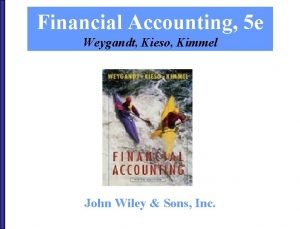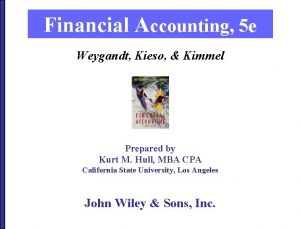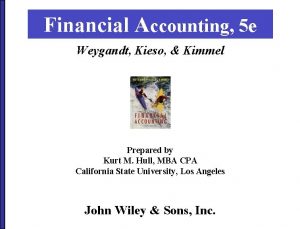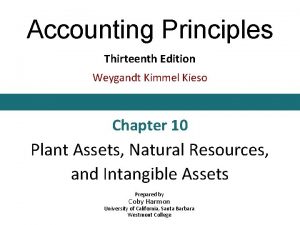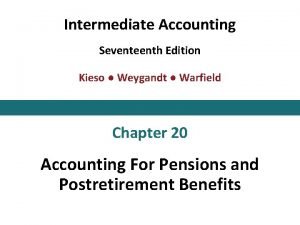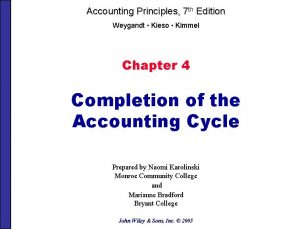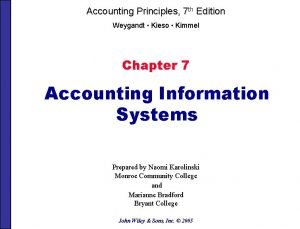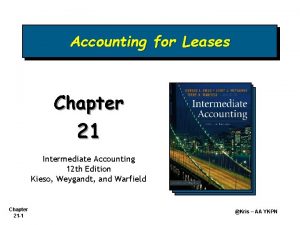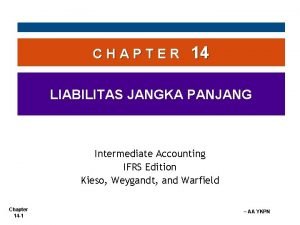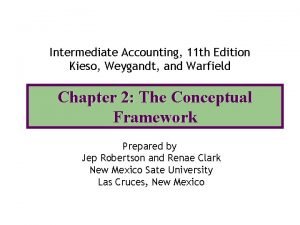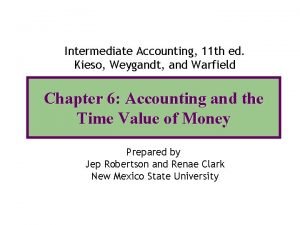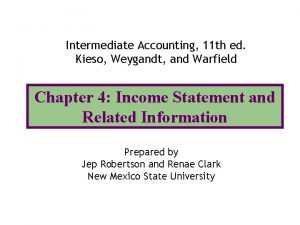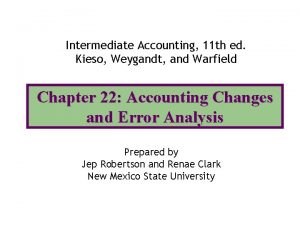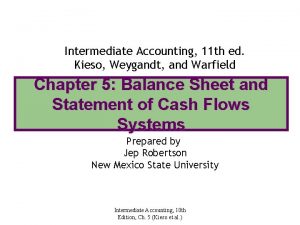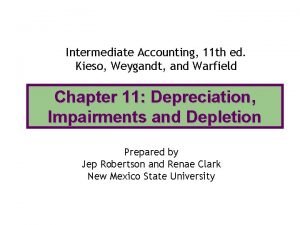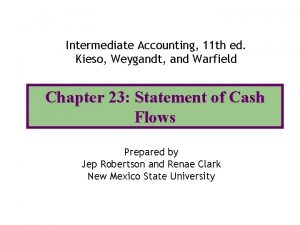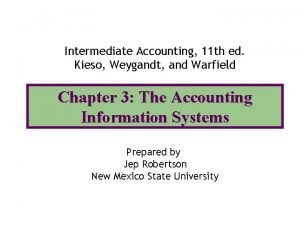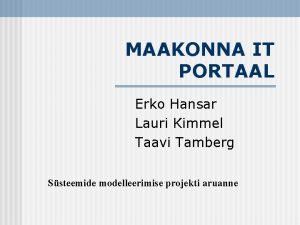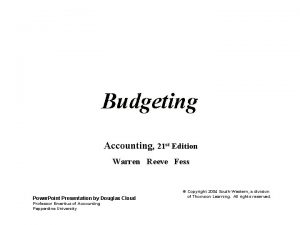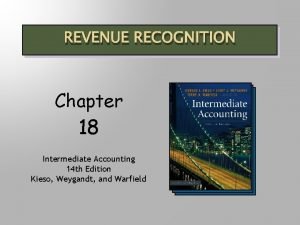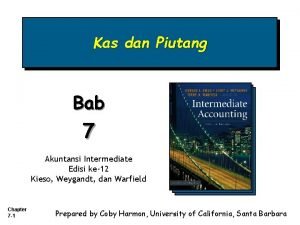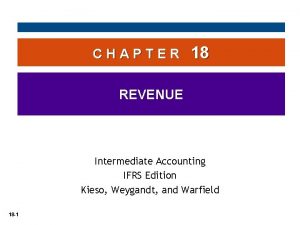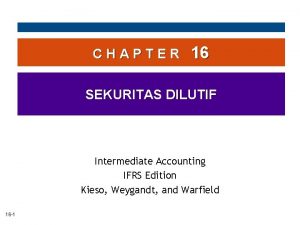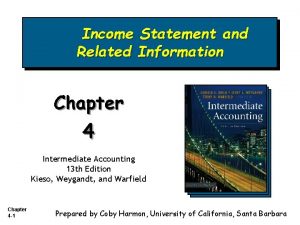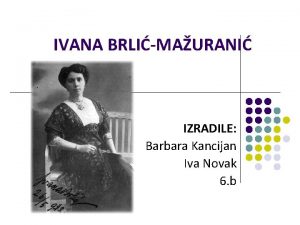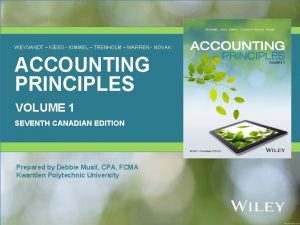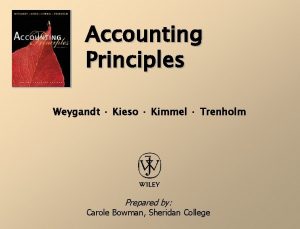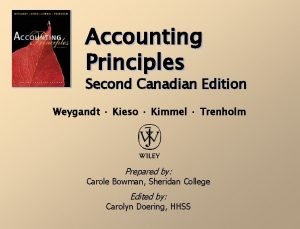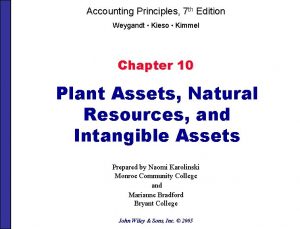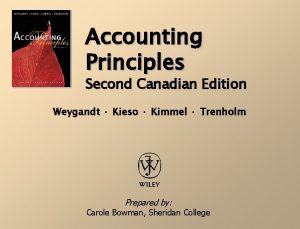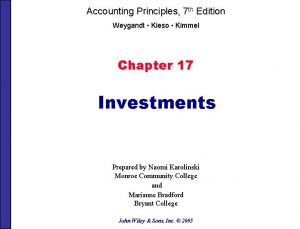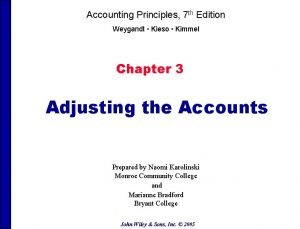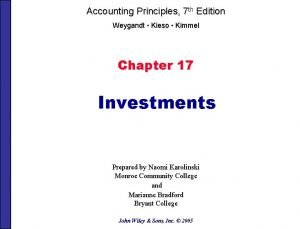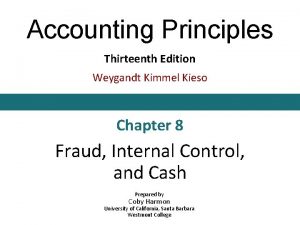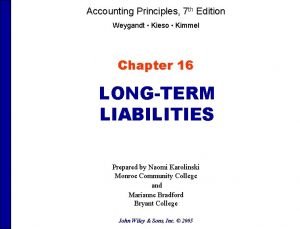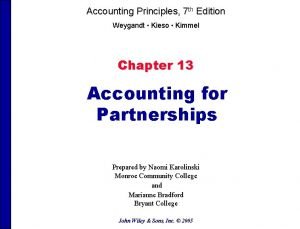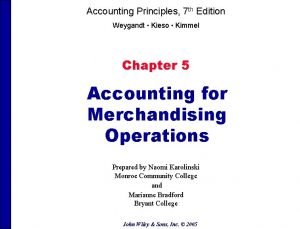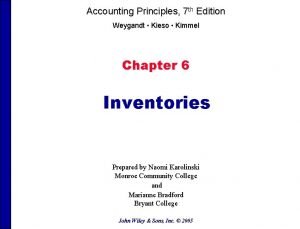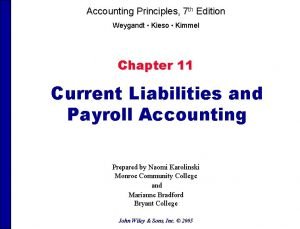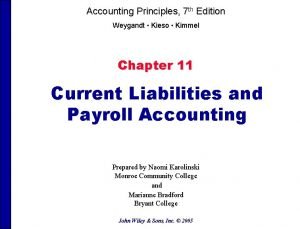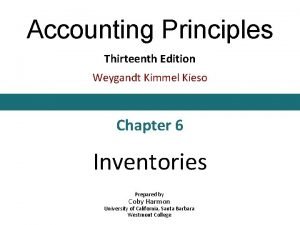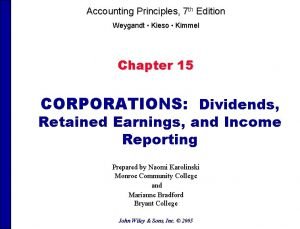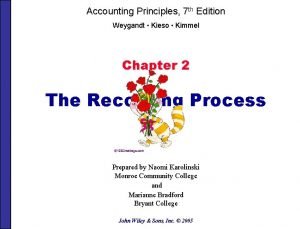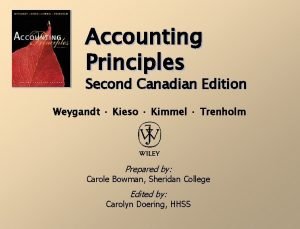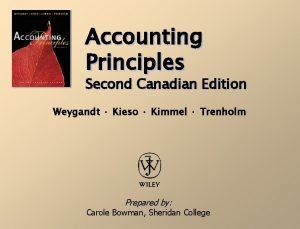WEYGANDT KIESO KIMMEL TRENHOLM WARREN NOVAK ACCOUNTING PRINCIPLES


















































- Slides: 50

WEYGANDT – KIESO - KIMMEL – TRENHOLM – WARREN - NOVAK ACCOUNTING PRINCIPLES VOLUME 1 SEVENTH CANADIAN EDITION Prepared by Debbie Musil, CPA, FCMA Kwantlen Polytechnic University

CHAPTER 5: ACCOUNTING FOR MERCHANDISING OPERATIONS

Accounting for Merchandising Operations • Merchandising operations • Recording purchases of merchandise • Recording sales of merchandise • Completing the accounting cycle • Merchandising financial statements • Using the information in the financial statements 3

CHAPTER 5: Accounting for Merchandising Operations LEARNING OBJECTIVES 1. Describe the differences between service and merchandising companies. 2. Prepare entries for purchases under a perpetual inventory system. 3. Prepare entries for sales under a perpetual inventory system. 4. Perform the steps in the accounting cycle for a merchandising company. 5. Prepare single-step and multiple-step income statements. 6. Calculate the gross profit margin and profit margin. 7. Prepare the entries for purchases and sales under a periodic inventory system and calculate cost of goods sold (Appendix 5 A). 4

Merchandising Operations • Purchasing products to resell to customers • Main source of revenue is sale of merchandise – Called Sales Revenue, or simply Sales • Two categories of expenses: – Cost of Goods Sold: cost of merchandise sold – Operating expenses: incurred in the process of earning sales revenue • Gross profit: difference between Sales Revenue and Cost of Goods Sold 5

Income Measurement Process for a Merchandising Company 6

Perpetual Inventory System • Maintains detailed records of inventory purchases and sales • Continuously (perpetually) shows quantity and cost of inventory that should be on hand for each item • Cost of Goods Sold is calculated and recorded at the time of each sale 7

Periodic Inventory System • Detailed inventory records are not kept throughout the period • Cost of Goods Sold is calculated only at the end of the accounting period (periodically) 8

CHAPTER 5: Accounting for Merchandising Operations LEARNING OBJECTIVES 1. Describe the differences between service and merchandising companies. 2. Prepare entries for purchases under a perpetual inventory system. 3. Prepare entries for sales under a perpetual inventory system. 4. Perform the steps in the accounting cycle for a merchandising company. 5. Prepare single-step and multiple-step income statements. 6. Calculate the gross profit margin and profit margin. 7. Prepare the entries for purchases under a periodic inventory system and calculate cost of goods sold (Appendix 5 A). 9

Perpetual Inventory System Recording Merchandise Purchases • When merchandise is purchased for resale: Dr. Merchandise inventory (for cost of goods) Cr. Accounts payable (purchases on credit) or Cash (cash purchases) • The purchase is normally recorded when the merchandise is received 10

Purchase Invoice

Recording Merchandise Purchase • What is the accounting entry? Merchandise Inventory 1000 Accounts Payable 1000 To record goods purchased on account, terms 2/10, n/30

Freight Costs • Purchase invoice indicates when ownership of the goods is transferred from buyer to seller • FOB (Free on Board) Shipping Point: – Buyer accepts ownership at place of shipping and pays for shipping costs – Buyer debits Merchandise Inventory for cost of shipping • FOB Destination: – Buyer accepts ownership when goods are delivered to buyer’s place of business and seller pays freight costs – Seller debits Freight Out for cost of shipping 13

Freight Costs

Freight Cost for Mr. Singh • Assume shipping costs are $50. What is the accounting entry? Dr. Merchandise Inventory 50 Cr. Cash 50 To record payment of freight on purchased goods

Purchase Returns & Allowances • Goods purchased may be damaged, defective, of inferior quality, or they may not meet purchaser’s specifications • Goods may be returned or purchase price may be reduced (an allowance) • Entry to record: Dr. Cash or Accounts payable Cr. Merchandise Inventory (for amount of return or adjustment) 16

Purchase Returns & Allowances • Purchase return is when buyer returns goods to the seller • Purchase allowance means buyer keeps good but the seller is willing to give a reduction from the price • If Mr. Singh returned defective basketballs to Nike costing $300, what would the transaction be?

Purchase Returns & Allowances The entry to record: Dr. Cash or Accounts payable $300 Cr. Merchandise Inventory To record return of goods to Nike $300

Quantity and Purchase Discounts • Quantity discount: reduction in price due to the quantity being purchased • Purchase discount: reduction in price due to early payment of amount due • If pay early and get a purchase discount: Dr. Accounts payable Cr. Merchandise Inventory (for amount of discount) Cr. Cash (for net amount paid) 19

Quantity and Purchase Discounts • On our invoice we notice 2/10 & n/30 • Lets assume that Mr. Singh pays the balance owing of $700 (gross invoice was $1000 less purchase returns and allowances of $300) on Sept 26 th 2017. What is the entry? • Dr. Accounts Payable 700 Cr. Merchandise Inventory 14 Cr. Cash 686

CHAPTER 5: Accounting for Merchandising Operations LEARNING OBJECTIVES 1. Describe the differences between service and merchandising companies. 2. Prepare entries for purchases under a perpetual inventory system. 3. Prepare entries for sales under a perpetual inventory system. 4. Perform the steps in the accounting cycle for a merchandising company. 5. Prepare single-step and multiple-step income statements. 6. Calculate the gross profit margin and profit margin. 7. Prepare the entries for purchases under a periodic inventory system and calculate cost of goods sold (Appendix 5 A). 21

Recording Sales of Merchandise • Revenue is recorded when goods are transferred from seller to buyer • Two entries needed to record the sale: – To record sales revenue: Dr. Cash or Accounts Receivable Cr. Sales – To record cost of goods sold: Dr. Cost of Goods Sold Cr. Merchandise Inventory 22

Purchase Invoice

• What is the accounting entry for Nike, assuming it costs them 500? Accounts Receivable 1000 Sales 1000 To record credit sale to Nemesis Sports Cost of Goods Sold Merchandise Inventory 500

Freight Costs • If FOB destination, seller pays freight – Not part of cost of goods sold – Instead are an operating expense of seller • Costs incurred to earn revenue are recorded as expenses 25

Sales Returns & Allowances • Sales returns: when customers return merchandise to seller for credit or refund • Sales allowances: when seller grants customers a price reduction • Contra revenue account used to provide information • Seller’s entry required: Dr. Sales returns and allowances Cr. Accounts receivable or cash • Also, if merchandise returned, and is saleable: Dr. Merchandise inventory Cr. Cost of goods sold 26

Sales Returns & Allowances • Earlier Mr. Singh returned defective basketballs totally $300. What is the accounting entry Nike would make? Sales Returns and Allowances 300 Accounts Receivable 300 To record credit granted to Nemesis Sports for returned goods

Sales Return & Allowances • If the merchandise returned is in good working condition, what is the accounting entry? Merchandise Inventory 150 Cost of Goods Sold 150 What if the merchandise is not in good working condition? Loss from damage goods 150 Cost of Goods Sold 150 • What type of account is “loss of damage goods”? • Expense Account

Sales Discounts • Discount offered for early payment of bill • Discount amount taken is credited to Sales Discounts (a contra revenue account) – Opposite of a purchase discount • Original amount in Sales is not changed – To record sales discount: Dr. Cash Dr. Sales Discounts Cr. Accounts Receivable 29

Sales Discount • What would the accounting entry be for Nike, given the discount to Nemesis? Cash 686 Sales Discount 14 Accounts Receivable 700 • If the discount was not taken, the only affected accounts would be Cash & A/R

Sales Taxes • Collected by merchandising companies on the goods that they sell • Sales taxes collected are not revenue – Treated as a liability until paid (as they are due to the government) – Periodically remitted to government 31

CHAPTER 5: Accounting for Merchandising Operations LEARNING OBJECTIVES 1. Describe the differences between service and merchandising companies. 2. Prepare entries for purchases under a perpetual inventory system. 3. Prepare entries for sales under a perpetual inventory system. 4. Perform the steps in the accounting cycle for a merchandising company. 5. Prepare single-step and multiple-step income statements. 6. Calculate the gross profit margin and profit margin. 7. Prepare the entries for purchases under a periodic inventory system and calculate cost of goods sold (Appendix 5 A). 32

Completing the Accounting Cycle • Same types of adjusting entries as a service company • One additional adjustment for inventory – To ensure the recorded inventory amount agrees with the actual quantity on hand • A physical count is an important control feature – A perpetual system indicates what should exist – An inventory count will determine what does exist • Additional accounts to be closed: – Sales, Sales Returns and Allowances, Sales Discounts, Cost of Goods Sold, Freight Out 33

Adjusting Entries • At Nike, accounting records show an ending inventory balance of $40 500 at the end of September and a physical inventory count indicates only $40 000. What is the adjusting entry? Cost of Goods Sold Merchandise Inventory 500

CHAPTER 5: Accounting for Merchandising Operations LEARNING OBJECTIVES 1. Describe the differences between service and merchandising companies. 2. Prepare entries for purchases under a perpetual inventory system. 3. Prepare entries for sales under a perpetual inventory system. 4. Perform the steps in the accounting cycle for a merchandising company. 5. Prepare single-step and multiple-step income statements. 6. Calculate the gross profit margin and profit margin. 7. Prepare the entries for purchases under a periodic inventory system and calculate cost of goods sold (Appendix 5 A). 35

Merchandising Income Statement • Single step: classified as revenues and expenses only • Multiple step: five main steps 1 Net Sales = Sales less returns, allowances, discounts 2 Gross Profit = Net Sales less Cost of Goods Sold 3 Profit from Operations = Gross Profit less Operating Expenses 4 Non-Operating Activities: activities not related to operations 5 Profit = Profit from Operations + Non-operating Activities 36

Single-Step Income Statement All data are classified as either (1) revenues or (2) expenses 37

Multiple-Step Income Statement 38

Classified Balance Sheet Merchandise Inventory reported as a current asset following Accounts Receivable 39

CHAPTER 5: Accounting for Merchandising Operations LEARNING OBJECTIVES 1. Describe the differences between service and merchandising companies. 2. Prepare entries for purchases under a perpetual inventory system. 3. Prepare entries for sales under a perpetual inventory system. 4. Perform the steps in the accounting cycle for a merchandising company. 5. Prepare single-step and multiple-step income statements. 6. Calculate the gross profit margin and profit margin. 7. Prepare the entries for purchases under a periodic inventory system and calculate cost of goods sold (Appendix 5 A). 40

Using the Information in the Financial Statements • Profitability ratios: measure profit or operating success for a specific time period • Gross profit margin: – Gross profit expressed as a percentage – Measures the effectiveness of a company’s purchasing and pricing policies 41

Using the Information in the Financial Statements 2 • Profit margin: – The percentage of sales that results in profit – Measures the ability of a company to cover all expenses and provide a return to owners = Profit ÷ Net Sales 42

CHAPTER 5: Accounting for Merchandising Operations LEARNING OBJECTIVES 1. Describe the differences between service and merchandising companies. 2. Prepare entries for purchases under a perpetual inventory system. 3. Prepare entries for sales under a perpetual inventory system. 4. Perform the steps in the accounting cycle for a merchandising company. 5. Prepare single-step and multiple-step income statements. 6. Calculate the gross profit margin and profit margin. 7. Prepare the entries for purchases under a periodic inventory system and calculate cost of goods sold (Appendix 5 A). 43

Appendix 5 A: Periodic Inventory System • Key differences compared to perpetual inventory system: – Calculation of Cost of Goods Sold is only performed at end of period • When physical inventory count is done – Accounting entries are different as a result 44

Recording Purchases of Merchandise • Merchandise Inventory account is not used; separate accounts are used instead: – Merchandise purchases are debited to Purchases account – Freight costs are debited to Freight In account – Returns and allowances are credited to Purchase Returns and Allowances account – Discounts are credited to Purchase Discounts account 45

Recording Sales of Merchandise • At time of sale, only Sales Revenue is recorded Dr. Accounts receivable or Cash Cr. Sales – No entry is made to recognize cost of sales • Freight costs, sales returns, allowances and sales discounts are treated the same as under a perpetual inventory system 46

Calculating Cost of Goods Sold • Calculation of Cost of Goods Sold is only performed at end of period – Use equation to calculate – Shown in detail on multiple step income statement 47

Calculating Cost of Goods Sold 2 • Cost of Goods Purchased – Add Purchases and Freight In – Subtract Purchase Returns and Allowances and Purchase Discounts • Cost of Goods on Hand – Based on physical count of inventory = Number of units counted x unit cost • Cost of Goods Sold = Cost of Goods on Hand at beginning of period + Cost of Goods Purchased – Cost of Goods on Hand at end of period 48

Completing the Accounting Cycle • Regular closing entries for all purchase and sales discounts, allowances, freight • Additional entry is required to close beginning merchandise inventory Dr. Income summary Cr. Merchandise Inventory • Another entry is required to establish ending merchandise inventory Dr. Merchandise Inventory Cr. Income summary 49

COPYRIGHT Copyright © 2016 John Wiley & Sons Canada, Ltd. All rights reserved. Reproduction or translation of this work beyond that permitted by Access Copyright (The Canadian Copyright Licensing Agency) is unlawful. Requests for further information should be addressed to the Permissions Department, John Wiley & Sons Canada, Ltd. The purchaser may make back-up copies for his or her own use only and not for distribution or resale. The author and the publisher assume no responsibility for errors, omissions, or damages caused by the use of these programs or from the use of the information contained herein.
 Kimmel weygandt kieso financial accounting 5th edition
Kimmel weygandt kieso financial accounting 5th edition Kimmel weygandt kieso accounting 5th edition
Kimmel weygandt kieso accounting 5th edition Financial and managerial accounting weygandt kimmel kieso
Financial and managerial accounting weygandt kimmel kieso Kimmel weygandt kieso accounting 5th edition
Kimmel weygandt kieso accounting 5th edition Weygandt kimmel kieso
Weygandt kimmel kieso Kieso weygandt warfield
Kieso weygandt warfield Kimmel financial accounting 7the edition
Kimmel financial accounting 7the edition Financial accounting kimmel ch1-2
Financial accounting kimmel ch1-2 Kimmel financial accounting 7e
Kimmel financial accounting 7e Chapter 21 accounting for leases kieso terjemahan
Chapter 21 accounting for leases kieso terjemahan Chapter 14 intermediate accounting kieso bahasa indonesia
Chapter 14 intermediate accounting kieso bahasa indonesia Primary qualities of accounting information
Primary qualities of accounting information Intermediate accounting kieso
Intermediate accounting kieso Intermediate accounting kieso
Intermediate accounting kieso Intermediate accounting kieso
Intermediate accounting kieso Intermediate accounting
Intermediate accounting Intermediate accounting kieso
Intermediate accounting kieso Intermediate accounting kieso
Intermediate accounting kieso Intermediate accounting kieso
Intermediate accounting kieso Intermediate accounting chapter 17 investments pdf
Intermediate accounting chapter 17 investments pdf Taavi kimmel
Taavi kimmel David kimmel design
David kimmel design Alexandra topp
Alexandra topp Sztenderdek
Sztenderdek Warren reeve fess accounting edition 21
Warren reeve fess accounting edition 21 Revenue recognition intermediate accounting
Revenue recognition intermediate accounting Chapter 7 kas dan piutang
Chapter 7 kas dan piutang Kieso chapter 18 revenue recognition terjemahan
Kieso chapter 18 revenue recognition terjemahan Kieso chapter 16 bahasa indonesia
Kieso chapter 16 bahasa indonesia Chapter 4 income statement and related information
Chapter 4 income statement and related information Pripovijetke vjenceslav novak
Pripovijetke vjenceslav novak Slidetodoc.com
Slidetodoc.com Iz velegradskog podzemlja karakterizacija likova
Iz velegradskog podzemlja karakterizacija likova When was novak djokovic born
When was novak djokovic born 黃鍔
黃鍔 Zincir kavram haritası örneği
Zincir kavram haritası örneği Oš vjenceslav novak
Oš vjenceslav novak Marijin pohod elizabeti
Marijin pohod elizabeti Vjenceslav novak černobil
Vjenceslav novak černobil Aldo novak
Aldo novak Vjenceslav novak ebrd
Vjenceslav novak ebrd Iva novak
Iva novak Inventarna knjiga
Inventarna knjiga Parataktischer stil
Parataktischer stil Anica novak
Anica novak Iz velegradskog podzemlja
Iz velegradskog podzemlja Novak y godwin, 1999
Novak y godwin, 1999 Dr sofia novak
Dr sofia novak Zatrdlina pod levim rebrnim lokom
Zatrdlina pod levim rebrnim lokom Abby novak
Abby novak Mrs. novak
Mrs. novak
